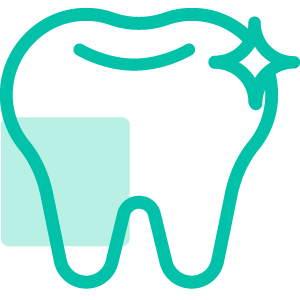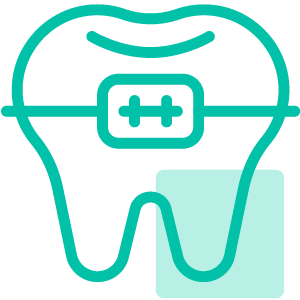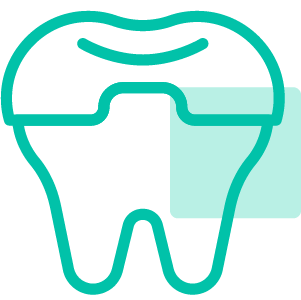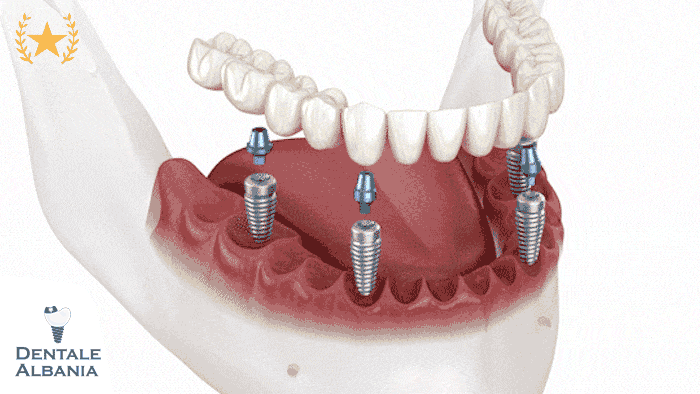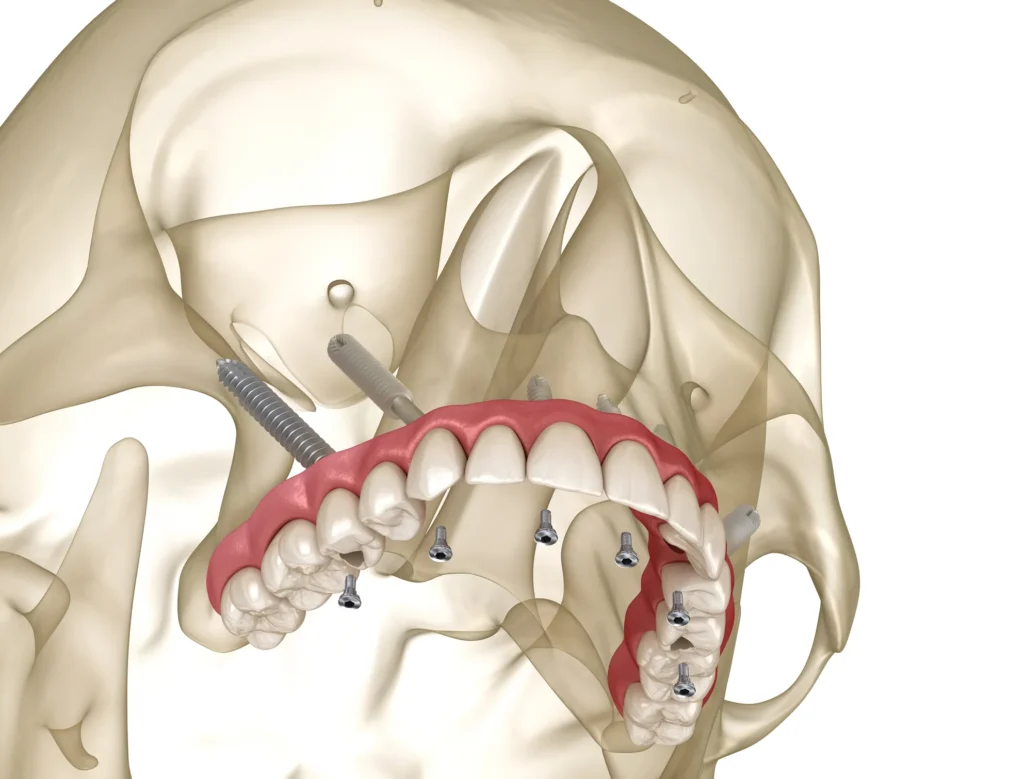Table of Contents
ToggleWhat Are Pterygoid dental implants? Understanding the Procedure and Purpose
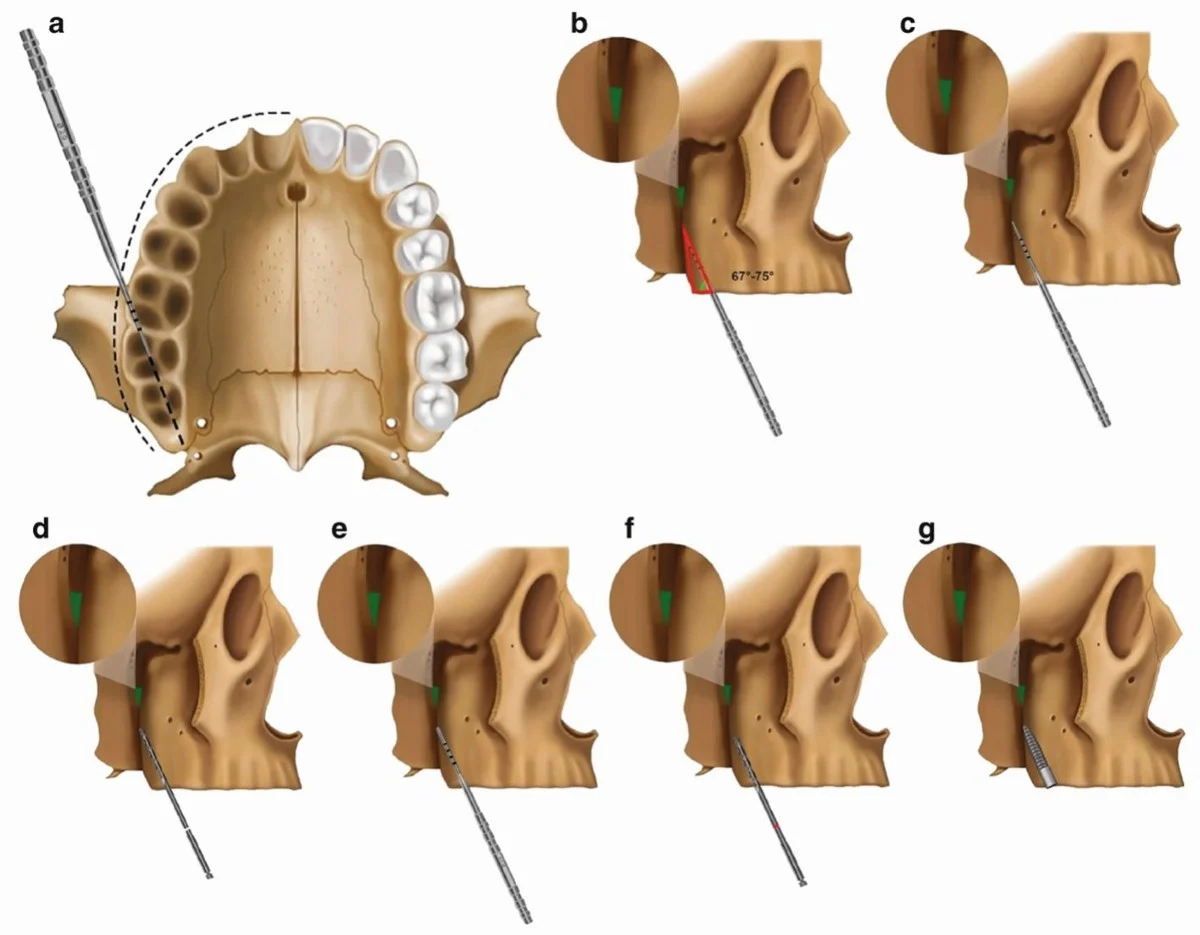
- Pterygoid dental implants are a specialized form of dental implants designed to solve one of the most difficult challenges in implant dentistry: replacing teeth in the severely atrophic upper jaw (posterior maxilla). When traditional implants can’t be placed due to insufficient bone volume or density, pterygoid implants step in as a graftless solution.
- These implants are longer than conventional ones and are placed at a precise 45–60° angle, starting in the maxillary tuberosity (the back part of the upper jaw) and anchored into the medial pterygoid plate of the sphenoid bone—a dense and stable bone that does not typically deteriorate with tooth loss.
- Unlike traditional implants, which are embedded vertically into the alveolar ridge (jawbone), pterygoid implants take advantage of dense, unaffected anatomical structures, making them ideal when the jawbone has undergone resorption or when sinus lift or bone grafting is not possible or desired.
- These implants are often referred to as pterygo-maxillary implants or tuberosity implants, and while the placement is technically more complex, their biomechanical stability is excellent. In fact, the posterior maxilla’s poor bone quality is bypassed entirely by reaching deeper, denser regions of bone.
- The design and insertion technique of pterygoid implants enable them to support full arch restorations, either independently or in combination with zygomatic and standard implants, especially in cases of severe bone loss.
- Patients who have been told they are not candidates for dental implants due to upper jaw deterioration may find that pterygoid implants provide a lifesaving alternative—often with faster treatment times and no need for complicated grafting procedures.
- They have also gained attention as a key part of advanced treatments like All-on-4 and All-on-6 protocols, providing posterior support and expanding the anterior-posterior spread needed for durable and stable full-arch prosthetics.
- Thanks to advancements in 3D imaging, CBCT scans, and guided implantology, the placement of pterygoid implants has become more precise, predictable, and safer, making them an increasingly popular solution for dentists and oral surgeons dealing with challenging upper jaw cases.
Where Are Pterygoid dental implants Placed and Why Does Location Matter?
- Pterygoid implants are uniquely positioned in the pterygomaxillary region—an anatomical area located behind the upper jaw. Specifically, these implants are anchored into the medial pterygoid plate of the sphenoid bone, beginning at the maxillary tuberosity, a part of the upper jaw near the wisdom teeth region.
- This region provides dense cortical bone, which is crucial for achieving strong primary stability, even in cases of extensive jawbone atrophy. Because this area is less affected by resorption compared to the alveolar ridge, it offers a reliable anchorage site for long-term prosthetic success.
- The implants are typically inserted at a posterior, upward, and medial angle (45–60 degrees) to bypass the maxillary sinus and directly engage with the stable pterygoid bone structure. This placement avoids the complications and healing delays associated with sinus lift surgery or bone grafting procedures.
- From a functional perspective, placing implants so far back in the mouth allows for expanded posterior support, which reduces or eliminates the need for prosthetic cantilevers—an advantage in full-arch restorations.
- The unique anatomical location also supports a better anterior-posterior (A-P) spread, which improves the biomechanics of the prosthesis. This means the forces of chewing and biting are distributed more evenly across the entire arch, reducing the risk of overload or implant failure.
- Clinicians emphasize the importance of careful radiographic planning—particularly CBCT (Cone Beam CT) scans—to map out the position of nearby critical structures, such as the pterygoid hamulus, maxillary artery, greater palatine canal, and sinus walls.
- Although access to this area can be challenging due to its posterior location and limited visibility, with proper technique and imaging, it becomes a predictable and reproducible option for implant-supported restorations in the upper jaw.
- Ultimately, the strategic placement of pterygoid implants in this dense, less-resorbed bone makes them a transformative option for patients who have been turned away from traditional implants due to upper jawbone loss.
How Do Pterygoid dental implants Compare to Zygomatic Implants?
When it comes to advanced dental implant solutions, both pterygoid implants and zygomatic implants play crucial roles. However, each type has unique characteristics, indications, and advantages that influence their selection for specific clinical situations.
What Is the Difference Between Pterygoid and Zygomatic Implants?
- Anatomical Anchorage Points:
- Pterygoid implants are anchored to the medial pterygoid plate behind the maxillary tuberosity. This placement engages dense bone away from the severely resorbed upper jawbone.
- Zygomatic implants, on the other hand, anchor to the zygoma (cheekbone). They traverse the sinus cavity, using the high-density zygomatic bone for stability.
- Implant Length and Complexity:
- Pterygoid implants generally range between 15–20mm in length, inserted at approximately a 45-degree angle to optimize stability.
- Zygomatic implants are significantly longer (30–55mm) due to the distance between the upper jaw and the zygomatic bone, making their placement more technically demanding.
- Indications and Preferences:
- Pterygoid implants are ideal when the posterior maxilla shows severe atrophy but the medial pterygoid plate area maintains dense bone quality.
- Zygomatic implants are indicated when the maxillary sinus is extensively pneumatized and the entire maxilla is severely atrophied, leaving limited or no viable bone anteriorly and posteriorly.
- Surgical Complexity and Technique:
- Placement of pterygoid implants requires a high degree of skill due to limited visibility and the blind surgical approach guided primarily by tactile sensations.
- Zygomatic implants require advanced surgical expertise and often general anesthesia or IV sedation, as they involve navigating close to the sinus cavity and orbit.
- Clinical Applications (e.g., All-on-4 or All-on-6):
- Pterygoid implants can be combined with standard or zygomatic implants for full arch restorations, commonly known as All-on-4 or All-on-6 protocols.
- Combining zygomatic implants and pterygoid implants can optimize the prosthetic anchorage and distribution of forces across an arch, especially in extreme bone-loss scenarios.
- Postoperative Recovery and Patient Comfort:
- Recovery from pterygoid implants tends to be faster due to their shorter length and less invasive placement technique, which avoids significant involvement of sinus structures.
- Recovery from zygomatic implants can be lengthier due to increased swelling and sinus involvement, requiring meticulous postoperative care.
- Risk and Complications:
- Pterygoid implant complications, although rare, may include sinus penetration or displacement due to inadequate angulation or placement errors.
- Zygomatic implant complications often involve sinusitis, implant infection, or discomfort due to sinus penetration or proximity to sensitive anatomical structures.
By understanding these distinctions, clinicians and patients can make informed decisions on choosing between pterygoid and zygomatic implants to achieve the best functional, aesthetic, and long-term results.
What Are the Key Benefits of Pterygoid dental implants in Severe Bone Loss Cases?
Pterygoid implants provide a powerful solution for patients suffering from severe maxillary atrophy. In cases where traditional implants are not viable due to insufficient bone in the upper jaw, pterygoid implants unlock a set of significant benefits, often allowing patients to avoid more invasive grafting surgeries.
How Do Pterygoid Implants Avoid the Need for Bone Grafting?
- Anchor in Dense Cortical Bone: Pterygoid implants engage the medial pterygoid plate and surrounding dense cortical bone—an area that doesn’t resorb after tooth loss—unlike the alveolar ridge.
- Bypass Sinus and Atrophied Ridge: They are placed behind the maxillary sinus, avoiding the need for sinus lift procedures which are time-consuming and prone to complications.
- Ideal for Long-Term Edentulous Patients: Patients who have worn dentures for many years often suffer significant bone loss. Pterygoid implants provide a graftless option for these cases.
- Simplify Treatment Plan: Since there’s no need for bone grafts or sinus augmentation, treatment time is shorter, recovery is faster, and fewer appointments are needed.
Can Pterygoid Implants Support a Full Arch Restoration?
- Full Arch Rehabilitation: Yes, pterygoid implants can be used to secure a full upper arch prosthesis, especially in combination with anterior implants or zygomatic implants.
- Ideal for All-on-4 or All-on-6 Techniques: Pterygoid implants serve as posterior anchors, expanding the anteroposterior spread of support, improving stability and reducing cantilevers.
- Immediate Loading Possibility: Thanks to their anchorage in dense cortical bone, pterygoid implants can often be used for immediate loading, allowing patients to receive fixed teeth within 24 hours.
- Improved Bite Force and Chewing Function: These implants allow fixed restorations in the posterior region, which significantly improves the ability to chew tough foods and maintain a natural bite.
What Are the Risks and Disadvantages of Pterygoid Implants?
While pterygoid implants offer transformative benefits for patients with atrophic maxillae, there are still risks and disadvantages to consider. Fortunately, most of these complications are rare and can often be mitigated when treatment is performed by experienced surgeons with advanced planning and imaging.
What Are the Disadvantages of Using Pterygoid Implants?
- Limited Interarch Space: Since pterygoid implants are placed far back, near the upper wisdom tooth area, they require sufficient interarch space. In cases with a deep bite or restricted space, prosthetic design may be challenging.
- Technique Sensitivity: The procedure is surgically demanding. It involves blind placement between the medial and lateral pterygoid plates and requires a high level of anatomical expertise.
- Steep Learning Curve: Many general dentists may not be trained or experienced in this advanced technique. Patients often need to be referred to maxillofacial surgeons or implant specialists.
- Reduced Visibility During Placement: The posterior region of the maxilla, where these implants are placed, is difficult to visualize directly. This can increase the complexity of precise angulation and positioning.
- Patient Discomfort During Surgery: The implant is typically placed while the patient is under IV sedation, as the surgical zone is deep and can be uncomfortable under local anesthesia alone.
- Incompatibility with Some Facial Implants: In rare instances, cosmetic cheekbone implants from reconstructive surgery may interfere with pterygoid implant placement.
Known Risks of Pterygoid Implants
- Displacement: Although rare, improper angulation or insufficient primary stability may cause implant displacement.
- Sinus Penetration: While pterygoid implants aim to bypass the sinus, improper trajectory can still lead to sinus perforation.
- Nerve Injury: Due to the deep location of placement, there is a slight risk of affecting adjacent nerves, leading to pain or altered sensation.
- Trismus or Limited Mouth Opening: Postoperative stiffness or limited ability to open the mouth can occur temporarily due to proximity to the pterygoid muscle.
- Cleaning Challenges: Being placed far posteriorly, some patients may initially find hygiene access to be more difficult, though proper design and patient education can overcome this.
How Long Is a Pterygoid Implant and What Is the Surgical Technique?
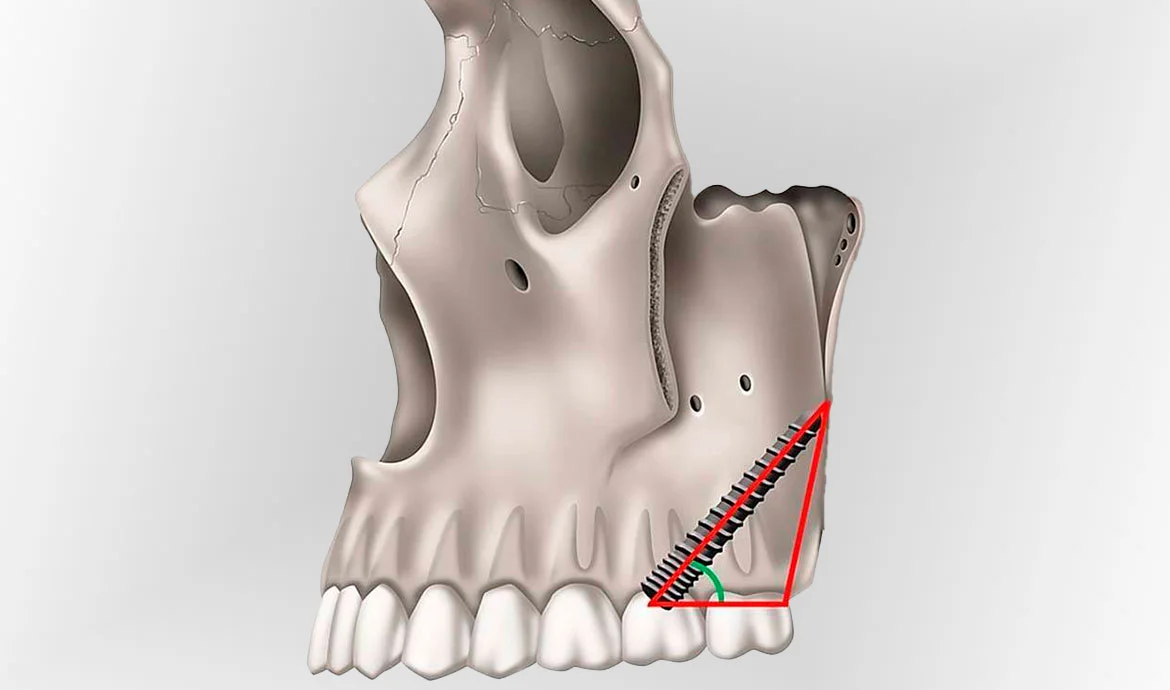
Pterygoid implants, specifically designed for patients with significant bone loss in the posterior maxilla, are longer than traditional dental implants. They typically range between 15 to 20 mm in length, with 15 mm being the most common length for typical procedures. The extended length allows the implant to bypass the atrophied bone in the maxilla and anchor into the dense pterygoid plate of the sphenoid bone, offering exceptional stability.
How Long Is a Pterygoid Implant?
- Standard Implant Length: The average pterygoid implant measures between 15 to 20 mm, longer than traditional implants due to its required path and anchor point.
- Why Length Matters: The extended length ensures the implant reaches into the dense bone of the pterygoid process, which helps to avoid complications related to lack of bone mass in the maxilla.
- Individual Adjustments: The exact length can vary depending on the patient’s anatomy and the specific case requirements, with custom modifications made based on the initial assessment.
What Is the Surgical Technique for Pterygoid Implant Placement?
The placement of pterygoid implants involves a precise and meticulous surgical technique due to their location in the posterior maxilla, near critical anatomical structures like the sinuses and nerves.
Steps Involved in the Surgical Technique
- Preoperative Planning: Advanced imaging techniques like CBCT (cone beam computed tomography) and 3D scans are essential to assess the patient’s anatomy and the available bone volume for the implant.
- Full-Thickness Flap: A full-thickness mucoperiosteal flap is elevated to expose the posterior maxillary region for accurate placement.
- Angulation and Positioning: The implant is positioned at a 45-degree angle, entering the maxillary tuberosity, and then directed towards the pterygoid plate, between the sphenoid and palatine bones. This requires precision in avoiding adjacent anatomical structures such as nerves and arteries.
- Implant Insertion: The implant is then placed, ensuring it engages the dense cortical bone of the pterygoid plate. Care is taken to avoid sinus perforation or damage to surrounding tissues.
- Healing and Follow-Up: Once the implant is in place, the area is closed, and patients undergo a period of osseointegration, with follow-up imaging to ensure proper healing. After healing, a prosthetic restoration can be placed on the implant.
Why Is Precision Important in Pterygoid Implant Surgery?
- Anatomical Challenges: The pterygoid region is difficult to access and requires expert knowledge of the bone anatomy to ensure the implant is placed at the correct angle and location.
- Risk Mitigation: Proper planning and surgical technique minimize the risk of complications like sinus penetration, nerve injury, or displacement. Using advanced imaging for accurate planning is critical to the success of the surgery.
- Long-Term Success: With the correct technique, pterygoid implants have a high success rate and can significantly improve patients’ ability to wear dental restorations without additional bone grafting or sinus lift procedures.
What Is the Anatomy Relevant to Pterygoid Implant Placement?
The anatomy of the pterygoid region plays a crucial role in the successful placement of pterygoid implants. This area is located in the posterior maxilla, and understanding the surrounding bones and structures is essential to ensure a precise and effective implant placement. The pterygoid implant procedure requires a detailed understanding of both the pterygoid process of the sphenoid bone and the maxillary anatomy to avoid complications and achieve a stable implant.
What Are the Key Bones Involved in Pterygoid Implant Placement?
- Sphenoid Bone: The pterygoid process of the sphenoid bone is the key anchoring point for pterygoid implants. This dense cortical bone provides the stability needed to hold the implant in place. The pterygoid process is located in the posterior portion of the maxilla, just behind the maxillary sinus.
- Maxillary Tuberosity: The maxillary tuberosity is the region from which the implant originates. It provides the initial point for insertion and guides the direction of the implant towards the pterygoid process.
- Palatine Bone: This bone forms the hard palate and is adjacent to the pterygoid region. Its position helps guide the implant’s pathway to ensure it remains in a stable and safe position, avoiding nearby sensitive structures.
What Are the Surrounding Anatomical Structures to Avoid During Implant Placement?
- Maxillary Sinus: One of the critical considerations during pterygoid implant surgery is avoiding perforation of the maxillary sinus. This sinus cavity is located close to the pterygoid region, and improper placement can result in sinus complications or infection.
- Nerves: Nearby nerve structures, including the infraorbital nerve and greater palatine nerve, must be considered. These nerves are important to avoid to prevent neurological complications like numbness or pain.
- Arteries: The palatine artery is another vital structure to be cautious of. If damaged, it could result in significant bleeding or other complications during surgery.
Why Is Advanced Imaging Crucial for Pterygoid Implant Surgery?
- Preoperative Imaging: Cone Beam Computed Tomography (CBCT) and other advanced imaging techniques help the surgeon visualize the anatomy of the maxilla, sinuses, and surrounding structures. These scans provide crucial details about the bone density, volume, and potential obstacles in the implant path.
- Planning for Safety: With detailed imaging, the surgeon can plan the precise angle, depth, and location of the pterygoid implant, minimizing risks and ensuring it avoids surrounding anatomical structures. Without this planning, the surgery could result in complications such as nerve damage or sinus perforation.
- Customized Approach: Each patient’s anatomy is unique, so using imaging allows for a personalized surgical plan, tailored to their specific needs and challenges.
What Is the Pterygoid Process and Why Is It Important?
- Definition of the Pterygoid Process: The pterygoid process is a prominent bony structure located at the base of the skull, part of the sphenoid bone. It extends laterally and acts as a strong anchor point for the pterygoid implants. The process itself consists of a pair of pterygoid plates (medial and lateral) that play a key role in holding the implant securely.
- Importance in Implant Placement: The cortical density of the pterygoid process provides an ideal foundation for implant stability. As the implant engages with this dense bone, it is less likely to experience failure, providing long-term support for the prosthetic tooth or bridge.
- Pathway for Implant: The implant must navigate through this process in a specific direction, entering from the maxillary tuberosity and angling towards the pterygoid plate, ensuring proper alignment and stability.
How Do You Release the Pterygoid Muscle and What Role Does It Play?
The pterygoid muscles are essential structures within the jaw that aid in the movement of the mouth and assist in chewing. These muscles are located deep within the face, running from the pterygoid processes of the sphenoid bone to various points in the jaw. Although these muscles are not typically a direct focus during pterygoid implant surgery, their proximity to the surgical site requires careful attention.
What Is the Role of the Pterygoid Muscle in Jaw Movement?
- Muscle Function: The pterygoid muscle, specifically the medial pterygoid and lateral pterygoid, plays an important role in the movement of the jaw. These muscles help in elevation, depression, protrusion, and side-to-side movement of the lower jaw, all of which are necessary for proper chewing and speaking functions.
- Medial Pterygoid: The medial pterygoid muscle is involved in closing the jaw during chewing. It works alongside the masseter muscle to elevate the mandible.
- Lateral Pterygoid: The lateral pterygoid muscle helps protrude the jaw and plays a key role in the lateral movement of the jaw, necessary for grinding food.
What Is Meant by “Releasing” the Pterygoid Muscle During Surgery?
- Releasing the Muscle: In some cases, during pterygoid implant placement, the surgeon may need to “release” the pterygoid muscle. This process typically refers to relieving tension or loosening the muscle to provide more space for the implant insertion.
- Muscle Release in Surgery: This procedure is not common in every pterygoid implant case but can be necessary if the muscle’s positioning obstructs the implant path. Releasing the muscle ensures that the implant can be placed at the correct angle and depth.
- Not Surgical Removal: It is important to note that “release” does not mean the muscle is removed or damaged during the procedure. Instead, the term refers to providing sufficient clearance for the implant insertion by temporarily relieving the tension in the muscle.
How Does the Pterygoid Muscle Impact the Success of Implant Placement?
- Avoiding Muscle Damage: Care must be taken during surgery to avoid excessive manipulation or damage to the pterygoid muscle. Any damage to these muscles could lead to functional issues, such as difficulty in chewing, pain, or jaw stiffness.
- Muscle Influence on Healing: The pterygoid muscle may also affect the healing process after implant surgery. Overuse or stress on the muscle post-surgery can delay healing, so surgeons must take care to minimize trauma to this region.
- Considerations for Implant Stability: While the pterygoid muscle does not directly influence the implant’s mechanical stability, releasing the muscle may ensure that the implant is placed in the ideal position, thereby contributing to better long-term results.
What Are the Considerations for Releasing the Pterygoid Muscle During Surgery?
- Surgical Planning: A detailed pre-surgical plan is essential to determine whether releasing the pterygoid muscle is necessary. Using advanced imaging, the surgeon can plan the precise path for the implant and avoid muscle interference.
- Surgeon Expertise: Releasing the pterygoid muscle requires a highly skilled surgeon. The procedure needs precision and understanding of both the anatomy and the function of the pterygoid muscle to avoid complications.
- Post-Operative Care: After surgery, the patient may need to undergo physical therapy or follow specific instructions to ensure that the muscle heals properly and that there are no adverse effects on jaw movement.
What Is the Success Rate of Pterygoid Implants Based on Clinical Research?
Pterygoid implants have shown to be an excellent option for patients with severe maxillary bone loss. When traditional implant procedures fail due to insufficient bone structure, pterygoid implants offer a viable alternative. The success rate of these implants has been well-documented through clinical studies, and they demonstrate promising results.
What Does Research Say About the Success Rate of Pterygoid Implants?
- High Success Rate: Studies on pterygoid implants report an impressive success rate of over 95% in long-term follow-ups. This makes them comparable to other well-established implant procedures, such as traditional maxillary implants and zygomatic implants.
- Long-Term Data: Research has shown that after the initial 6-month healing period, pterygoid implants tend to show stable integration with the surrounding bone. Patients typically experience little to no implant failure, which makes them a reliable option for those facing severe bone resorption in the maxilla.
- Comparative Success: Pterygoid implants have demonstrated similar or better success rates than sinus lifts or bone grafting alternatives, which can be riskier and more invasive. Many patients opt for pterygoid implants precisely because they eliminate the need for additional bone augmentation procedures.
What Are the Key Factors Contributing to High Success Rates?
- Anatomical Positioning: The key to pterygoid implant success lies in their unique placement in the pterygomaxillary region, where bone quality and density are optimal. By bypassing atrophied parts of the maxilla, pterygoid implants anchor into denser bone, reducing the risks associated with bone grafting.
- Proper Surgical Technique: Success is heavily dependent on the surgeon’s experience and expertise. Specialized training is required to place these implants accurately and with minimal complication.
- Immediate Loading: Pterygoid implants allow for immediate loading in some cases, which enhances the overall stability of the prosthetic restoration. This immediate stabilization plays a crucial role in maintaining implant success.
- Minimizing Bone Resorption: Pterygoid implants help prevent the further resorption of jawbone that often occurs after conventional implants fail. Their precise placement ensures that the implant maintains its stability and the surrounding bone is preserved.
How Does the Success of Pterygoid Implants Compare to Other Types of Implants?
- Compared to Zygomatic Implants: Pterygoid implants offer an advantage in that they are placed in denser bone compared to zygomatic implants, which often require navigating the maxillary sinus. The success rate of pterygoid implants is often higher because they avoid complications related to sinus membranes.
- Compared to Bone Grafting: One of the most significant advantages of pterygoid implants is that they eliminate the need for bone grafting. Bone grafting procedures can result in complications such as graft rejection, infection, or prolonged recovery periods. With pterygoid implants, patients can avoid these challenges, leading to faster recovery and better overall outcomes.
- Compared to Conventional Implants: Conventional implants are often not suitable for patients with significant bone loss or maxillary atrophy. Pterygoid implants provide an effective alternative for such cases, offering better results in extreme bone loss scenarios.
What Studies and Clinical Data Support the Effectiveness of Pterygoid Implants?
- Meta-Analysis and Systematic Reviews: Clinical studies and systematic reviews have demonstrated that pterygoid implants show long-term stability with fewer complications. A 6-year follow-up study published in 2022 reported a 95% success rate for pterygoid implants, which aligns with other advanced implant options, such as zygomatic implants.
- Case Studies: Numerous case studies highlight the effective use of pterygoid implants in patients who have previously failed conventional implants or have had sinus issues. These case studies show that pterygoid implants successfully rehabilitate patients with severe bone loss and offer an alternative for those previously unable to receive dental implants.
What Is the Long-Term Success of Pterygoid Implants for Patients?
- Stability and Durability: Research indicates that pterygoid implants continue to perform effectively for over 5 years, with minimal complications. Many patients who have undergone pterygoid implant placement report improved quality of life, as they no longer need to rely on uncomfortable dentures or other temporary solutions.
- Patient Satisfaction: Studies also show high levels of patient satisfaction with pterygoid implants. Most patients who undergo this procedure report significant improvements in functionality (such as chewing and speaking), as well as aesthetics, with the successful integration of prosthetic teeth.
Who Are the Best Candidates for Pterygoid Implants?
Pterygoid implants are specifically designed for patients who face severe bone loss in the upper jaw and are not ideal candidates for traditional implants or bone grafting procedures. These implants offer a solution for those who have experienced atrophy of the maxilla due to long-term tooth loss, failed implant surgeries, or insufficient bone structure. Below are the primary patient criteria and conditions that make someone a suitable candidate for pterygoid implants.
What Are the Clinical Indications for Pterygoid Implants?
- Severe Maxillary Atrophy: Pterygoid implants are most effective for patients suffering from significant bone loss in the posterior maxilla (upper jaw). This condition is often due to long-term tooth loss, which leads to the shrinking of the bone and makes traditional implant procedures difficult or impossible.
- Sinus Pneumatization: Patients who have undergone sinus pneumatization, where the maxillary sinuses expand and reduce the available bone for implant placement, are ideal candidates for pterygoid implants. The implants bypass the maxillary sinus and anchor into denser bone, avoiding the complications of sinus lifts or bone grafts.
- Failed Previous Implant Procedures: Many patients who have previously undergone sinus lifts, bone grafting, or zygomatic implants may find that these procedures either failed or were not suitable for their anatomy. Pterygoid implants can provide a graftless solution and restore function and aesthetics in cases where traditional implants were unsuccessful.
Why Are Pterygoid Implants Ideal for Patients with Advanced Bone Loss?
- No Need for Bone Augmentation: One of the biggest advantages of pterygoid implants is their ability to bypass the need for bone grafting. Patients who have been told that implants aren’t an option due to bone loss can still qualify for pterygoid implants, as they use bone areas that are not affected by atrophy.
- Stability in Dense Bone: The placement of pterygoid implants in the pterygoid plate ensures that the implant is anchored in dense cortical bone. This provides superior stability compared to other methods that rely on the atrophic alveolar ridge, which has reduced bone mass.
- Immediate Loading Capabilities: Many patients opt for pterygoid implants because they can often receive immediate loading. This means the replacement teeth are attached on the same day as the implants, avoiding the need for temporary dentures during the healing period.
What Are the Necessary Pre-Surgery Assessments for Pterygoid Implant Candidates?
- CBCT Scanning and Bone Mapping: Before undergoing surgery, a Cone Beam CT (CBCT) scan is essential to map the bone and assess its quality and quantity. This imaging allows the surgeon to determine the best implant position and angle for optimal success.
- Health Status: Candidates must be in good overall health to ensure the body can handle the surgery and healing process. For patients with medical conditions like diabetes or cardiovascular issues, a thorough evaluation by a healthcare provider is necessary to ensure the patient is fit for the procedure.
- Oral Hygiene: Good oral hygiene is a must before surgery. Patients are typically instructed to undergo non-surgical periodontal therapy to ensure their mouth is free of infection and ready for implant placement.
Why Are Pterygoid Implants a Good Option for Those with Sinus Issues?
- Bypassing Sinus Complications: For patients with sinus issues or sinusitis, traditional implant procedures can be risky. Pterygoid implants bypass the sinus cavity by anchoring into the pterygoid plate behind the maxilla. This technique avoids the complications often associated with sinus lifts and sinus augmentation procedures.
- No Need for Sinus Lift Surgery: Sinus lift procedures, which are commonly needed for patients with sinus expansion, can be time-consuming and come with risks like infection or graft rejection. Pterygoid implants provide a graftless solution, eliminating the need for this extra surgery.
Who Should Not Consider Pterygoid Implants?
- Severe Bone Resorption in Key Areas: If a patient has minimal bone in the pterygomaxillary region, they may not be a suitable candidate for pterygoid implants. Detailed imaging, including CT scans, can help determine if this procedure is feasible.
- Compromised General Health: Patients with severe systemic health conditions (such as uncontrolled diabetes, immunosuppression, or heart disease) may need to delay or forgo this surgery until their condition is managed appropriately. A complete medical evaluation is required for these cases.
What Are the Considerations Before Choosing Pterygoid Implants?
- Consultation with a Specialized Surgeon: Pterygoid implant placement is a highly specialized procedure. It’s essential to work with a surgeon who has extensive experience in implant dentistry and is familiar with the anatomical challenges involved in placing pterygoid implants.
- Understanding the Surgical Process: Patients should be aware that pterygoid implants are placed at a 45-degree angle into dense bone, and this requires a skilled surgeon to navigate safely around sensitive structures, such as nerves and blood vessels.
What Are the Steps in the Pterygoid Dental Implant Procedure?
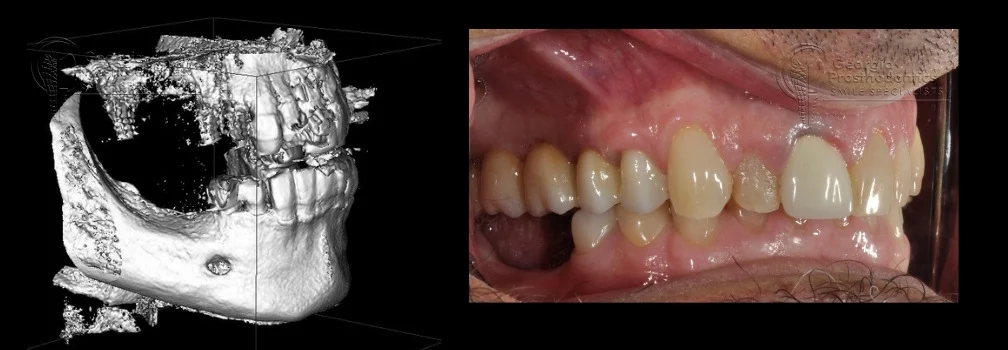
The process of placing pterygoid implants involves several key stages, from initial consultation to the final placement of prosthetic teeth. This treatment is designed for patients with significant bone loss in the upper jaw, and the procedure is aimed at restoring function and aesthetics with a graftless solution. Here are the critical steps involved in the pterygoid dental implant procedure.
Initial Consultation and Assessment
- Comprehensive Health Evaluation: Before proceeding with the implant surgery, patients undergo a thorough health assessment to ensure they are in good condition for surgery. This includes evaluating oral health, bone density, and any pre-existing conditions that could affect healing, such as diabetes or heart disease.
- Detailed Imaging: A Cone Beam CT (CBCT) scan is performed to assess the bone structure and map out the pterygoid region. The scan helps the surgeon determine if there is enough bone in the pterygoid plate for successful implant placement. It also allows the surgeon to plan the angle and position of the implants.
- Discussion of Treatment Plan: During the consultation, the surgeon discusses the benefits of pterygoid implants and how they compare to other options like sinus lifts, zygomatic implants, and traditional implants. The patient is given a clear understanding of the surgical process, recovery, and expected results.
Surgical Procedure: Implant Placement
- Anesthesia and Sedation: The procedure begins with local anesthesia to numb the area, ensuring the patient remains comfortable throughout the surgery. In some cases, intravenous (IV) sedation may be used to help the patient relax.
- Flap Creation: A small incision is made in the gum to create a flap. This provides the surgeon with access to the underlying bone. In pterygoid implant placement, this step is crucial to ensure proper visualization of the pterygoid region and surrounding structures.
- Implant Placement: The surgeon carefully places the pterygoid implant at a 45-degree angle through the maxillary tuberosity, crossing over to the pterygoid plate of the sphenoid bone. The implant is then anchored securely into dense cortical bone to ensure stability.
- Surgical Precision: The placement of pterygoid implants requires specialized training and significant precision. The surgeon must navigate around delicate anatomical structures such as nerves, blood vessels, and the sinus cavity. Proper surgical technique is essential for ensuring long-term success.
Healing and Integration: The Importance of Osseointegration
- Healing Time: After the implants are placed, the patient enters the healing phase, during which the implants will integrate with the bone. This process, known as osseointegration, typically takes several months to complete. During this time, the patient is monitored for any signs of infection or complications.
- Follow-up Appointments: The patient will have follow-up appointments to ensure the implants are healing properly and to address any concerns. X-rays or CT scans may be taken to assess the integration of the implants with the bone.
- No Immediate Loading for Some: In some cases, patients may need to wait before loading the implants with prosthetic teeth. However, immediate loading may be possible depending on the stability and health of the implant.
Prosthetic Attachment: Final Restoration
- Impression for Prosthetics: Once the implants have fully integrated into the bone, impressions are taken of the patient’s mouth. These impressions are used to create custom prosthetic crowns, bridges, or dentures that will be fixed to the implants.
- Attachment of Prosthetic Teeth: After the prosthetic teeth are created in a lab, they are securely attached to the implants using abutments or screw-retained prosthetics. The final restoration restores full functionality to the upper jaw, including the ability to chew, speak, and smile with confidence.
- Occlusion Adjustment: The surgeon will perform a thorough adjustment of the bite to ensure the prosthetics align correctly and comfortably with the patient’s natural teeth.
Recovery and Aftercare
- Post-Surgery Care: After the procedure, the patient will receive specific instructions for post-surgical care, including how to manage swelling, pain, and any potential discomfort. Ice packs and pain medication are typically recommended to reduce swelling and manage any pain.
- Dietary Restrictions: For the first few days after surgery, patients may need to follow a soft-food diet to avoid putting too much pressure on the healing area. Avoiding hard or sticky foods will help prevent complications during the recovery phase.
- Oral Hygiene: Proper oral hygiene is essential to prevent infection and ensure the long-term success of the implants. Patients are instructed to carefully clean the surgical site and use antiseptic mouthwashes as prescribed by the surgeon.
- Regular Follow-Up Visits: Patients will have regular check-ups to monitor the healing progress and ensure that the implants remain stable and functional.
What Is the Success Rate of Pterygoid Implants?
The success of pterygoid implants has been well-documented in clinical studies, with success rates comparable to those of other implant techniques. In general, pterygoid implants offer a high degree of stability and longevity, making them a reliable option for patients with advanced bone loss.
What Are Some Real-World Results from Pterygoid Implant Cases?
Pterygoid implants have been utilized for many years to provide graftless solutions to patients with severely atrophic maxillas. This section will explore some of the real-world results and outcomes from pterygoid implant cases, demonstrating their effectiveness in restoring both function and aesthetics in complex dental situations.
Case Study: Successful Full-Arch Restoration with Pterygoid Implants
- Patient Overview: This case involves a 60-year-old patient with significant maxillary bone loss due to prolonged tooth loss. The patient had previously undergone several failed implant procedures and had been told that further implants were not possible.
- Treatment Plan: After assessing the patient’s anatomy with CBCT scans, the treatment plan included the placement of four pterygoid implants, two in the anterior maxilla, and two at the posterior regions of the maxilla, into the pterygoid plate. The goal was to restore the patient’s entire upper arch with a fixed, full-mouth restoration.
- Procedure: The pterygoid implants were carefully placed using the specialized surgical technique described earlier, ensuring that the implants were securely anchored in the dense cortical bone of the pterygoid plate.
- Outcome: The implants integrated successfully, and within a few months, the patient was fitted with a permanent prosthesis. The full-arch restoration improved both the patient’s ability to chew and speak, providing them with a natural smile and confidence. The patient reported excellent functionality and comfort, with no issues related to implant displacement or discomfort.
- Patient Satisfaction: The patient was highly satisfied with the restoration, especially considering the earlier failed attempts at other dental treatments. The use of pterygoid implants made it possible to avoid bone grafting and sinus augmentation, which would have extended the recovery period.
Case Study: Rescue Treatment After Zygomatic Implant Failure
- Patient Overview: A 55-year-old patient, who had undergone zygomatic implants in the past, experienced complications due to infection and sinusitis, which led to implant failure in the posterior maxilla.
- Treatment Plan: The patient was referred for the placement of pterygoid implants as a rescue solution. The treatment involved removing the failed zygomatic implants and placing two pterygoid implants to secure a full-arch restoration without the need for additional bone grafting or sinus lifting.
- Procedure: The pterygoid implants were placed through the maxillary tuberosity, angling toward the pterygoid plate. Special care was taken to avoid any sinus complications and ensure a proper angulation for ideal stability.
- Outcome: The pterygoid implants successfully integrated into the bone, and the patient’s arch was restored using a screw-retained prosthesis. The immediate loading technique allowed the patient to have functional teeth immediately after surgery.
- Patient Satisfaction: The patient reported no further complications, and the restoration provided stability and comfort for the patient who had struggled with previous implant failures. The use of pterygoid implants as a rescue option allowed the patient to avoid further major surgeries and provided them with a durable, long-lasting solution.
Key Benefits Observed from Real-World Results
- Graftless Solutions: Pterygoid implants have been a game-changer for patients who require a graftless solution to replace missing teeth in the posterior maxilla. These implants bypass the need for bone grafting, sinus lifts, or other complex procedures, significantly reducing the treatment time and costs.
- Immediate Loading Options: In many cases, pterygoid implants can support immediate loading, which means patients can have their prosthetic teeth attached shortly after the implants are placed. This is a major advantage for those who wish to avoid long periods without teeth or who need quick results.
- Improved Function and Stability: By anchoring implants in the dense bone of the pterygoid plate, pterygoid implants provide excellent stability, making them an ideal option for full-arch reconstructions. Patients experience improved chewing ability, speech clarity, and enhanced comfort.
- Minimized Complications: The risk of complications such as sinus issues, nerve damage, or implant displacement is minimized with pterygoid implants when performed by experienced surgeons. These implants provide a secure and stable base for restorations, offering a low-risk solution for patients with severe bone loss.
Long-Term Results and Follow-Up
- Longevity of Pterygoid Implants: Long-term studies and patient follow-ups show that pterygoid implants have a high success rate over time, with many patients enjoying stable and functional restorations for years. Success rates of 95% and higher have been reported, showing that these implants provide a long-term solution for edentulous patients with atrophic maxillas.
- Post-Surgery Monitoring: Regular follow-up visits ensure that the implants remain stable and the surrounding bone remains healthy. This includes monitoring the prosthetic restoration and ensuring that patients maintain oral hygiene to prevent infection and ensure the longevity of the implant.
What Are the Risks and Disadvantages of Pterygoid Implants?
While pterygoid implants offer many benefits, they are not without risks and disadvantages. Understanding these risks is crucial for patients considering this treatment.
Frequently Asked Questions About Pterygoid Implants
In this section, we will answer some of the most common questions patients and dental professionals have about pterygoid implants. These answers aim to clarify the process, benefits, risks, and suitability of pterygoid implants for various dental conditions.
What Are the Risks of Pterygoid Implants?
- Possible Complications: While the risks associated with pterygoid implants are minimal, they still exist. Some potential risks include implant displacement, sinus penetration, and nerve injury. These complications are rare when performed by experienced surgeons, but they can occur in certain cases.
- Sinus Issues: Since pterygoid implants are placed near the maxillary sinus, there is a small risk that the implants could penetrate the sinus cavity. Surgeons take care to avoid this by using advanced imaging techniques and a precise surgical approach.
- Nerve Damage: The proximity to the pterygoid nerve and other vital structures can cause issues, although these are generally rare. Local anesthesia is used to minimize discomfort, and careful surgical planning can reduce the risk of nerve injury.
- Post-Surgery Care: Following the procedure, patients are given specific post-operative instructions to minimize complications. These typically include advice on maintaining oral hygiene, managing swelling, and following up regularly with the dentist.
What Is the Difference Between Pterygoid Implants and Zygomatic Implants?
- Anchorage Points: The main difference between pterygoid implants and zygomatic implants is the location where they are anchored. Pterygoid implants are placed in the pterygoid process of the sphenoid bone, while zygomatic implants anchor into the cheekbone (zygomatic bone).
- Procedure Complexity: Zygomatic implants are generally longer and more complex to place than pterygoid implants. The angle at which zygomatic implants are placed is steeper, and the surgical approach is more invasive, often requiring a larger incision.
- Bone Involvement: Pterygoid implants bypass the atrophied maxilla and use the dense bone of the pterygoid region for anchorage. Zygomatic implants, on the other hand, are more commonly used in patients with significant bone loss in the upper jaw and are often used in combination with other implants to restore full arch functionality.
- Ideal Candidates: Both types of implants are used in cases of severe bone loss, but zygomatic implants are often used in patients who have very little bone left in the upper jaw, while pterygoid implants are used when the posterior maxilla is insufficient for traditional implant placement but still offers some viable bone quality.


